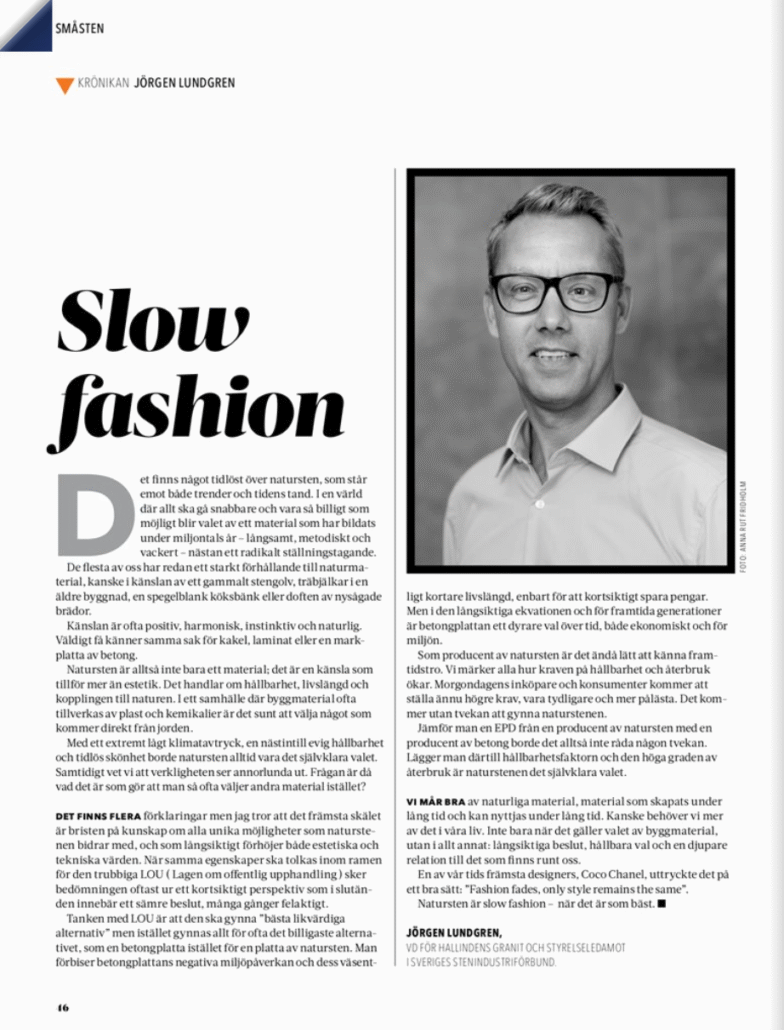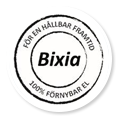Column – Slow fasion
Our CEO, Jörgen Lundgren, has written a column about Slow Fashion in the latest issue of the magazine ”Sten” (Stone), issue 3/2025.
There is something timeless about natural stone — it resists both trends and the wear of time. In a world where everything is expected to move faster and cost less, choosing a material that has taken millions of years to form — slowly, methodically, and beautifully — becomes almost a radical statement. Most of us already have a strong connection to natural materials, the feeling of an old stone floor, the wooden beams of an old building, a mirror-polished kitchen countertop, or the scent of freshly sawn timber.
The feeling is often positive, harmonious, instinctive, and natural. Very few people experience the same connection to tiles, laminate, or a concrete paving slab.
Natural stone is not just a material — it is a feeling that adds more than aesthetics. It represents durability, longevity, and a connection to nature. In a society where building materials are often made from plastics and chemicals, it is a sensible choice to use something that comes directly from the earth.
With an extremely low climate footprint, almost eternal durability, and timeless beauty, natural stone should always be the obvious choice. Yet we know that reality often looks different. So the question is: what makes people so often choose other materials instead?
There are several explanations, but I believe the main reason is the lack of knowledge about all the possibilities that natural stone offers — possibilities that, in the long run, enhance both aesthetic and technical value. When these same qualities are interpreted within the narrow framework of the Public Procurement Act, assessments are often made from a short-term perspective, leading to poorer — and often incorrect — decisions.
The intention of the law is to promote the “best equivalent alternative”, but too often it favors the cheapest one — such as a concrete slab instead of natural stone. The negative environmental impact and the much shorter lifespan of concrete are overlooked, all in the name of short-term cost savings. But in the long-term equation — for both the economy and the environment — the concrete slab is the more expensive choice.
As a producer of natural stone, it is nevertheless easy to feel hopeful about the future. We can all see how demands for sustainability and reuse are increasing. Tomorrow’s buyers and consumers will be even more demanding, more conscious, and better informed — and that will undoubtedly benefit natural stone.
If you compare an EPD from a natural stone producer with one from a concrete producer, there should be no doubt. Add the sustainability factor and the high potential for reuse, and natural stone becomes the natural choice.
We thrive in environments made from natural materials — materials that has formed slowly and is meant to last. Perhaps we need more of that in our lives, not only in the choice of building materials, but in everything else — long-term decisions, sustainable choices, and a deeper relationship with the world around us.
As one of the greatest designers of our time, Coco Chanel, once said: “Fashion fades, only style remains the same.”
Natural stone is slow fashion — at its very best.
Jörgen Lundgren, CEO Hallindens Granit and board member of the Swedish Stone Industries Federation ”Sveriges Stenindustriförbund”











